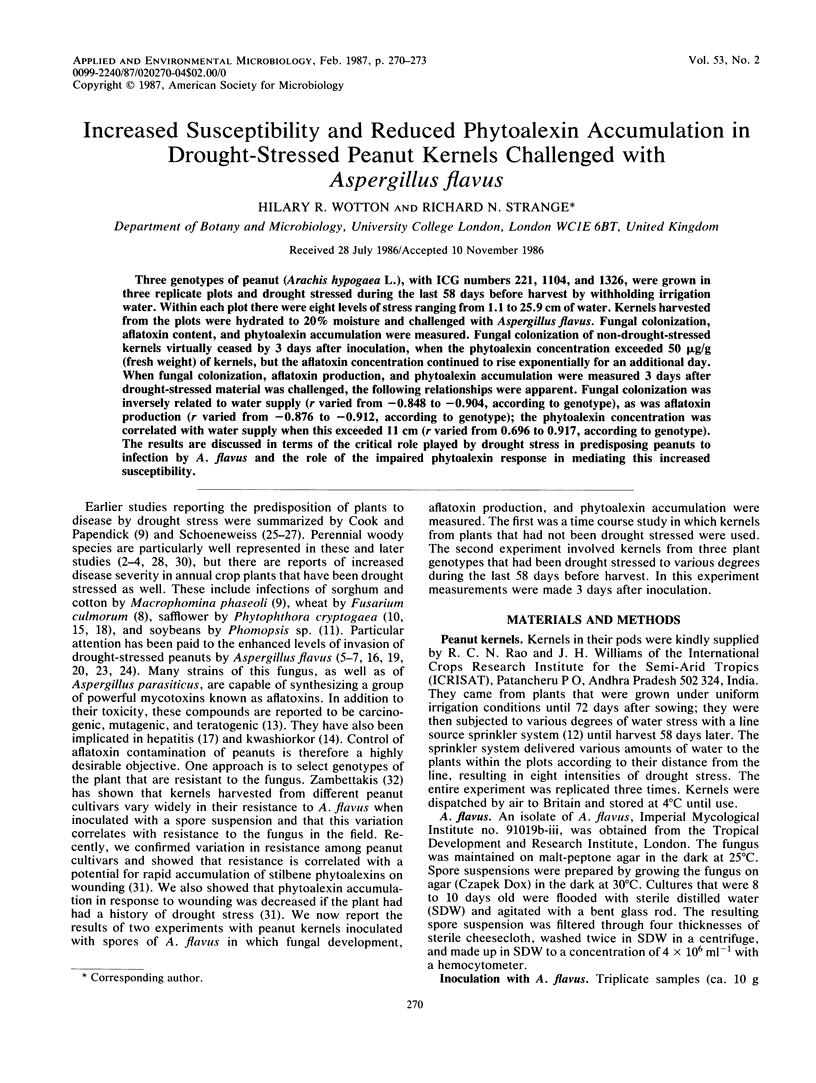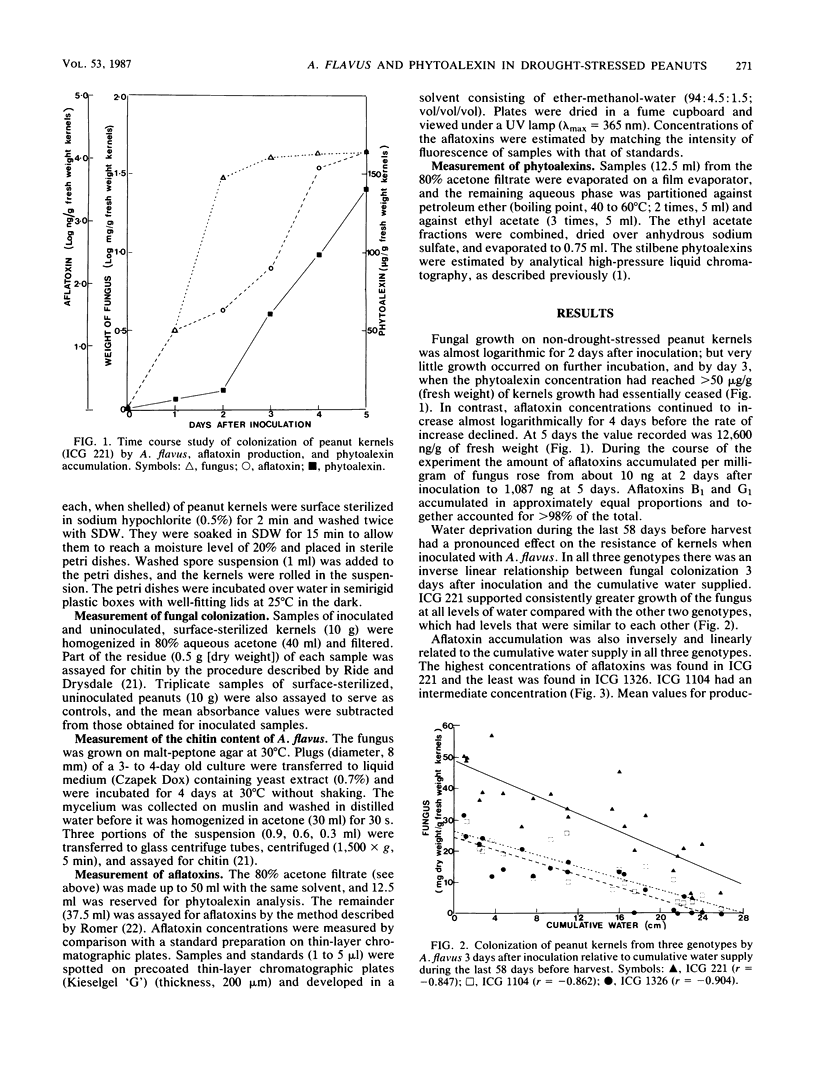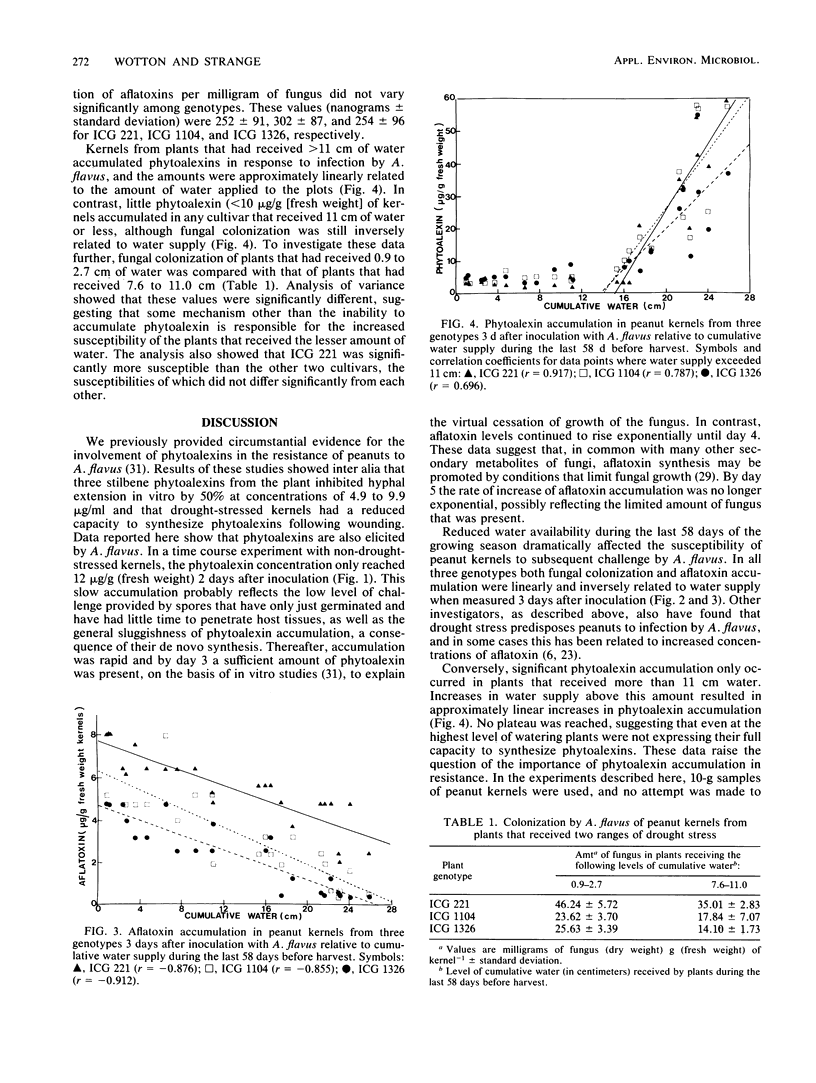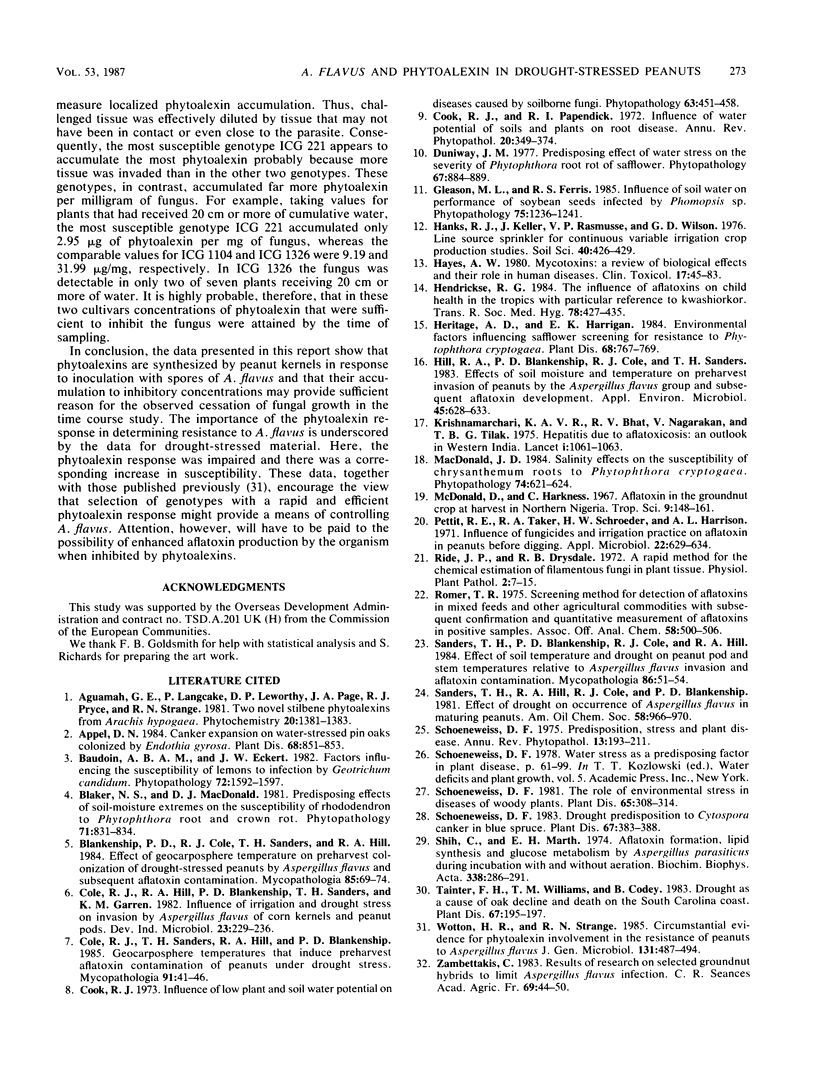Abstract
Three genotypes of peanut (Arachis hypogaea L.), with ICG numbers 221, 1104, and 1326, were grown in three replicate plots and drought stressed during the last 58 days before harvest by withholding irrigation water. Within each plot there were eight levels of stress ranging from 1.1 to 25.9 cm of water. Kernels harvested from the plots were hydrated to 20% moisture and challenged with Aspergillus flavus. Fungal colonization, aflatoxin content, and phytoalexin accumulation were measured. Fungal colonization of non-drought-stressed kernels virtually ceased by 3 days after inoculation, when the phytoalexin concentration exceeded 50 micrograms/g (fresh weight) of kernels, but the aflatoxin concentration continued to rise exponentially for an additional day. When fungal colonization, aflatoxin production, and phytoalexin accumulation were measured 3 days after drought-stressed material was challenged, the following relationships were apparent. Fungal colonization was inversely related to water supply (r varied from -0.848 to -0.904, according to genotype), as was aflatoxin production (r varied from -0.876 to -0.912, according to genotype); the phytoalexin concentration was correlated with water supply when this exceeded 11 cm (r varied from 0.696 to 0.917, according to genotype). The results are discussed in terms of the critical role played by drought stress in predisposing peanuts to infection by A. flavus and the role of the impaired phytoalexin response in mediating this increased susceptibility.
Full text
PDF



Selected References
These references are in PubMed. This may not be the complete list of references from this article.
- Blankenship P. D., Cole R. J., Sanders T. H., Hill R. A. Effect of geocarposphere temperature on pre-harvest colonization of drought-stressed peanuts by Aspergillus flavus and subsequent aflatoxin contamination. Mycopathologia. 1984 Mar 15;85(1-2):69–74. doi: 10.1007/BF00436705. [DOI] [PubMed] [Google Scholar]
- Cole R. J., Sanders T. H., Hill R. A., Blankenship P. D. Mean geocarposphere temperatures that induce preharvest aflatoxin contamination of peanuts under drought stress. Mycopathologia. 1985 Jul;91(1):41–46. doi: 10.1007/BF00437286. [DOI] [PubMed] [Google Scholar]
- Flaim S. F., Brannan M. D., Swigart S. C., Gleason M. M., Muschek L. D. Neuroleptic drugs attenuate calcium influx and tension development in rabbit thoracic aorta: effects of pimozide, penfluridol, chlorpromazine, and haloperidol. Proc Natl Acad Sci U S A. 1985 Feb;82(4):1237–1241. doi: 10.1073/pnas.82.4.1237. [DOI] [PMC free article] [PubMed] [Google Scholar]
- Hayes A. W. Mycotoxins: a review of biological effects and their role in human diseases. Clin Toxicol. 1980 Aug;17(1):45–83. doi: 10.3109/15563658008985070. [DOI] [PubMed] [Google Scholar]
- Hendrickse R. G. The influence of aflatoxins on child health in the tropics with particular reference to kwashiorkor. Trans R Soc Trop Med Hyg. 1984;78(4):427–435. doi: 10.1016/0035-9203(84)90052-x. [DOI] [PubMed] [Google Scholar]
- Hill R. A., Blankenship P. D., Cole R. J., Sanders T. H. Effects of soil moisture and temperature on preharvest invasion of peanuts by the Aspergillus flavus group and subsequent aflatoxin development. Appl Environ Microbiol. 1983 Feb;45(2):628–633. doi: 10.1128/aem.45.2.628-633.1983. [DOI] [PMC free article] [PubMed] [Google Scholar]
- Krishnamachari K. A., Bhat R. V., Nagarajan V., Tilak T. B. Hepatitis due to aflatoxicosis. An outbreak in Western India. Lancet. 1975 May 10;1(7915):1061–1063. doi: 10.1016/s0140-6736(75)91829-2. [DOI] [PubMed] [Google Scholar]
- Pettit R. E., Taber R. A., Schroeder H. W., Harrison A. L. Influence of fungicides and irrigation practice on aflatoxin in peantus before digging. Appl Microbiol. 1971 Oct;22(4):629–634. doi: 10.1128/am.22.4.629-634.1971. [DOI] [PMC free article] [PubMed] [Google Scholar]
- Romer T. R. Screening method for the detection of aflatoxins in mixed feeds and other agricultural commodities with subsequent confirmation and quantitative measurement of aflatoxins in positive samples. J Assoc Off Anal Chem. 1975 May;58(3):500–506. [PubMed] [Google Scholar]
- Sanders T. H., Blankenship P. D., Cole R. J., Hill R. A. Effect of soil temperature and drought on peanut pod and stem temperatures relative to Aspergillus flavus invasion and aflatoxin contamination. Mycopathologia. 1984 Apr 30;86(1):51–54. doi: 10.1007/BF00437229. [DOI] [PubMed] [Google Scholar]
- Wotton H. R., Strange R. N. Circumstantial evidence for phytoalexin involvement in the resistance of peanuts to Aspergillus flavus. J Gen Microbiol. 1985 Mar;131(3):487–494. doi: 10.1099/00221287-131-3-487. [DOI] [PubMed] [Google Scholar]


